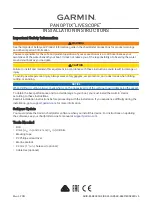
2
Section 1
An Introduction to Dielectric Withstand Testing with the HT-PR
The continuity test/dielectric withstand test is a production line test which is recognized by safety
agencies worldwide as a valid criterion of safe assembly of end-use equipment. The test ensures
that the primary circuit power and ground conductors were properly wired and connected for safe
operation. It also applies a high-voltage potential between power and ground conductors to make
sure that no unintentional leakage or arcing paths exist between power and ground. The test
consists of a ground continuity check, a leakage current check and a high voltage check. It is
non-destructive to the equipment under test, and can be accomplished in a short time.
The purpose of dielectric testing: Dielectric testing is a simple, non-destructive method of
verifying the adequacy of electrical insulation to withstand the sort of transients that can occur
during transient (surge) events. In addition, the dielectric test can verify that the insulation in
question has an adequate amount of performance "headroom". This is necessary to ensure that
the insulation does not fail because of degradation of the insulation due to aging, moisture, wear
due to vibration, etc.
The method of dielectric testing: A high voltage (typically 1000 Volts or higher) is applied
between two conductors that are "supposed" to be electrically insulated from each other. If the
two conductors (an insulated "live" wire, and a metal enclosure, for example) are completely
isolated from each other, then the application of a large voltage difference between the two
conductors will not allow current to flow between the conductors. The insulation will
"withstand" the application of a large voltage potential between the two conductors - hence the
term "dielectric withstand test". In general, there are two results of the test that are considered a
failure of the insulation: (1) excessive current flow during the test due to low insulation
resistance of the insulating material which separates the two conductors, and (2) an abrupt
dielectric breakdown due to electrical arcing or discharge, either through the insulation material,
over the surface of the insulation material, or a discharge through air.
The determination of a suitable test voltage: If the test voltage is too low, the insulation material
in question will not be adequately stressed during the test. This could cause inadequate
insulation to pass the test, and be considered acceptable. On the other hand, if the test voltage is
too high, then the test could cause permanent damage to an insulation material that is otherwise
adequate for the application. A general "rule of thumb" that is used for the testing of mains
wiring which operates at voltages of 120-240Vac is 1000V plus two times the operating voltage.
Using this rule, 120V wiring would be tested using a voltage of 1240Vac.
Duration of the test: Generally, the test voltage is applied for one minute, in order to adequately
stress the insulation. Many standards allow the test duration to be reduced to 1 second for
production-line testing in order to accommodate large-volume production testing. In this case,
standards quite often require that the test voltage be increased by 20% in order to ensure that the
shorter test duration of one second will adequately test the insulation in question
The following figure show the most common application of this tester, in this kind of devices the
three different test are perform, the ground connection between the exposed metal or Chassis
with the grounding pin of the power supply, the insulation and leakage current between the
primary power and the ground pin of the device are verified.
Summary of Contents for HT-2000PR
Page 2: ......
Page 4: ...ii...
Page 7: ...1...
Page 20: ...14 Figure 3 Controls Indicators Connectors Model HT 3000PR Front Panel...
Page 22: ...16 Figure 4 Controls Indicators Connectors HT PR Rear Panel...









































